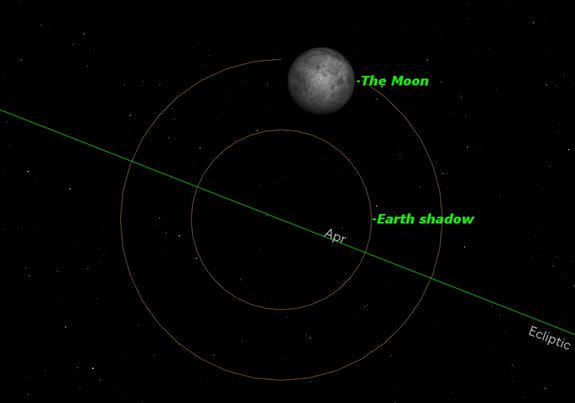The moon will dip through part of Earth's shadow in a partial lunar eclipse on Friday (Oct. 18), but it may be tough to see for skywatchers in North America.
If you look closely at any shadow cast by the sun, say the one cast by your hand on a piece of paper, you will notice that the edge of the shadow isn't sharp. That's because the sun is not a point source of light. It is a disk, so the shadows it casts are slightly fuzzy. The solid dark part of the shadow is called the "umbra" (Latin for "shade"). The fuzziness along the shadow's edge is called the "penumbra" (Latin for "almost shade"). [
See amazing penumbral lunar eclipse photos by stargazers]
When a shadow is cast by a nearby object, the penumbra is very slight. But when the shadow is as far away as the moon is from the Earth — about 238,000 miles (384,400 kilometers) on average — the penumbra is quite wide.
The sky chart included in this guide shows the
lunar eclipse setup at the time of maximum eclipse, which will occur at 7:50 p.m. EDT (2350 GMT) Friday. The inner circle is the umbra, the outer circle the penumbra. The moon makes it part way into the penumbra, but misses the umbra completely, hence this is a "partial penumbral eclipse."
For observers in North America and South America, maximum eclipse will be around the time of moonrise, which is also the time of sunset. This will make the eclipse difficult to see, because we will be looking for a slight dimming of the moon which is already dimmed by passing through a great deal of the Earth’s atmosphere.
The farther east and north you are located, the better your chances of seeing this eclipse.
For example, in New York City, the moon will rise at 5:59 p.m. EDT, and will be at an altitude of 20 degrees at maximum eclipse. In Chicago, moonrise is at 5:54 p.m. CDT and the moon’s altitude only 9 degrees at maximum eclipse. In Los Angeles, moonrise is at 6:09 p.m. PDT, more than an hour after maximum eclipse, so the chances of seeing the eclipse are zero.
For observers in North America, the effects of the Earth's shadow on the moon will be most pronounced on the lower right corner of the moon.
The shadow will probably be more pronounced in photographs than with the naked eye, so this is a good opportunity to get out your telephoto lens and
photograph the rising moon. Remember that maximum eclipse will be at 7:50 p.m. EDT/6:50 p.m. CDT.
For observers in Africa, Europe, and western Asia, the eclipse will occur in the middle of the night when the moon is high overhead. The partial shading will be visible as a slight reddish dimming of the normally bright full moon.
Editor's note: If you snap a photo of Friday's penumbral lunar eclipse and would like to share it with SPACE.com for a possible gallery or story, send images and comments to Managing Editor Tariq Malik at:
spacephotos@space.com.
Copyright 2013 SPACE.com, a TechMediaNetwork company. All rights reserved. This material may not be published, broadcast, rewritten or redistributed.











